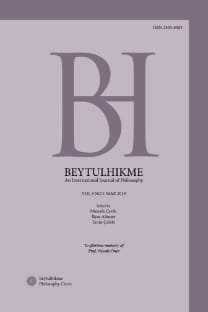Evrimsel Bir Rastlantı Olarak Dini İnanç
Bu yazı dini inancın 'yüksek yapılı' sistemlerin bir yan ürünü ya da önceden varolan uyarlamalar olarak toplumsal dünyada nasıl ortaya çıktıklarını tartışmaktadır. Yazı, insan zihninin genel alışkanlıkları yüzünden dinin evrensellerinin varolduğunu iddia eden kanı- tın sunulmasıyla başlar: Her şeyin 'etkenleri ve tasarımcıları" oldu- ğu düşüncesi ile bedenler ve ruhların ayrı olduğu şeklindeki düalizm konusunda bir ortak duyuya sahip olma düşüncesi. Yazı ayrıca bu düşünme alışkanlıklarının birbirine karştırılmalarını da açıklamaktadır.
Religious Belief as an Evolutionary Accident
This chapter discusses how religious belief emerges as a byproduct of 'highly structured' systems, or preexisting adaptations in the social world. It starts by presenting evidence that argues that the universals of religion exist because of the general habits of the human mind: The thought of having 'agents and designers' of everything, and having a common sense on dualism that bodies and souls are distinct. It further explains the implications of these habits of thinking
___
- Atran, Scott (2002a), In Gods We Trust: The Evolutionary Landscape of Religion (New York: Oxford University Press).
- Barrett, J. L. (2004), Why Would Anyone Believe in God? (Walnut Creek, Calif.: AltaMira Press).
- Bering, J. M. (2006), 'The Folk Psychology of Souls', Behavioural and Brain Sciences, 29: 453--62.
- Bering, J. M. and D. F Bjorklund (2004), 'The Natural Emergence of Reasoning about the Afterlife as a Developmental Regularity', Developmental Psychology, 40: 217--33.
- Blackmore, Susan (1999), The Meme Machine (New York: Oxford University Press).
- Bloom, Paul and C. Veres (1999), 'The Perceived Intentionality of Groups', Cogni- tion, 71: B1-B9.
- Bloom, Paul and D. S. Weisberg (2007), 'Childhood Origins of Adult Resistance to Science', Science, 316: 996-7.
- Bloom, Paul (2004), Descartes' Baby: How the Science of Child Development Explains What Makes Us Human (New York: Basic Books).
- Bloom, Paul (2007), 'Religion is Natural', Developmental Science, 10: 147-51.
- Boyer, P. and C. Ramble (2001), 'Cognitive Templates for Religious Concepts: Crosscultural Evidence for Recall of Counter-intuitive Representations', Cognitive Science, 25: 535-64.
- Boyer, P. (2001b), Religion Explained: The Evolutionary Origins of Religious Thought (New York: Basic Books).
- Calvin, J. (1960), Institutes of the Christian Religion, trans. Ford Lewis Battles (Phi- ladelphia, Penn.: Westminster Press).
- Csibra, G., S. Biro, O. Koos, and G. Gergely (2003), 'One-Year-Old Infants Use Teleological Representations of Actions Productively', Cognitive Science, 27: 111-- 33.
- Dawkins, Richard (1986), The Blind Watchmaker: Why the Evidence of Evolu- tion Reveals a Universe Without Design (New York: Norton).
- Evans, E. M. (2000), 'Beyond Scopes: Why Creationism is Here to Stay', in K. Rosengren, C. Johnson, and P. Harris (eds.), Imagining the Impossible: Magical,
- Evans, E. M. (2001), 'Cognitive and Contextual Factors in the Emergence of Diverse
- Gould, Stephen J. (and R. C. Lewontin (1979), 'The Spandrels of San Marco and the Panglossian Paradigm: A Critique of the Adaptationist Programme', Pro- ceedings of the Royal Society of London (Biological Sciences), 205: 581-98.
- Gottfried, G. M., S. A. Gelman, and H. Schultz (1999), 'Children's Early Under- standing of the Brain: From Early Essentialism to Naïve Theory', Cognitive Development, 14: 147--74.
- Guthrie, Stewart E. (1993), Faces in the Clouds (New York: Oxford University Press).
- Hamlin, J. K., K. Wynn, and P. Bloom (2007), 'Social Evaluation by Preverbal Infants', Nature, 450: 557--8.
- Johnson, Carl Nils (1990), 'If You Had My Brain, Where Would I Be? Children's Understanding of the Brain and Identity', Child Development, 61: 962--72.
- Johnson, Dominic and Jesse Bering (2006), 'Hand of God, Mind of Man: Pu- nishment and Cognition in the Evolution of Cooperation', Evolutionary Psyc- hology, 4: 219--33.
- Kelemen, D. (2004), 'Are Children "Intuitive Theists"?: Reasoning about Purpose and Design in Nature', Psychological Science, 15: 295-301.
- Lillard, A. S. (1996), 'Body or Mind: Children's Understanding of Pretense', Child Development, 67: 1717--34.
- Mackie, J. L. (1983), The Miracle of Theism: Arguments For and Against the Existence of God (New York: Oxford University Press).
- Newman, G. E., F. C. Keil, V Kuhlmeier, and K. Wynn (manuscript), 'Sensitivity to Design: Early Understandings of the Link between Agents and Order', Proceedings of the National Academy of Sciences.
- Pinker, Stephen (1997), How the Mind Works (New York: Norton).
- Plantinga, Alvin (1991), 'Theism, Atheism, and Rationality', Truth Journal, 3: 1--8.
- Plantinga, Alvin (2000), Warranted Christian Belief (New York: Oxford University Press).
- Pyysiäinen, I. (2001b), How Religion Works: Towards a New Cognitive Science of Religion (Leiden: Brill).
- Scientific and Religious Thinking in Children (Cambridge: Cambridge University Press), 305--31.
- Shermer, Michael (2003), How We Believe: The Search for God in an Age of Science (New York: Freeman).
- Wilson, David Sloan (2002), Darwin's Cathedral: Evolution, Religion, and the Nature of Society (Chicago, Ill.: University of Chicago Press).
- ISSN: 1303-8303
- Başlangıç: 2011
- Yayıncı: Mustafa Çevik
Sayıdaki Diğer Makaleler
A Brief Account of the Relation between Prudence and Decision in Aristotle's Nicomachean Ethics
Evrimsel Bir Rastlantı Olarak Dini İnanç
Franz Kafka'nın Eserlerinde Yabancılaşma Problemi
Riemann'ın Geometri Felsefesinde Uzay Görüsünün Yeri Var mı?
Riemann'ın Geometri Felsefesinde Uzay Görüsünün Yeri Var mı?
A Brief Account of the Relation between Prudence and Decision in Aristotle's Nicomachean Ethics
